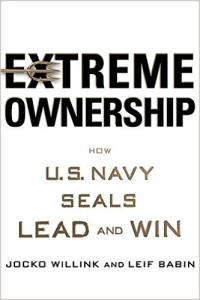<< Back to articles
Extreme overship
14 December 2015 
HOW U.S. NAVY SEALS LEAD AND WIN
 Business leaders would agree that pushing past your comfort zone is often critical to success. For me, reading this riveting book was both emotional and inspiring. While my reality is far from a combat zone, the similarities between the set of skills of a good army commander that help his team accomplish the most difficult missions in combat and those of an effective business leader are surprising. The authors share their combat stories (winning and failed) and apply these leadership principles to businesses and organizations to help them build their own high-performance teams.
Business leaders would agree that pushing past your comfort zone is often critical to success. For me, reading this riveting book was both emotional and inspiring. While my reality is far from a combat zone, the similarities between the set of skills of a good army commander that help his team accomplish the most difficult missions in combat and those of an effective business leader are surprising. The authors share their combat stories (winning and failed) and apply these leadership principles to businesses and organizations to help them build their own high-performance teams.
The authors start by highlighting the importance of selecting the right members for the team and the value of training in order to identify high-performing individuals. They go on to list the skills of leaders who exercise Extreme Ownership. These people are the backbone of the effective, productive and performing teams. Their key message being: there are no bad teams, only bad leaders.
Here are some principles to keep in mind:
- A great leader takes the blame for his team’s loss. All responsibility for success and failure of the team rests with the leader. Good leaders do not look for excuses to justify failure. They take the blame and find ways to reach their goals. This way, everyone on their team learns to take responsibility and ownership.
- The attitude of a leader sets the tone for the entire team. During training, the performance of Team 1 was terrible; they were losing over and over again. Then a new leader (from a high-performing, winning Team 2) took charge of them. The performance of the previously losing Team 1 started to improve and soon they scored their first victory. Meanwhile, Team 2, which lost their strong leader, still continued to perform well, powered by the winning culture of Extreme Ownership instilled by their original leader.
- A good leader does not only give orders and push his team, he goes to the frontlines with them, he LEADS his people. A good leader lives the same reality, hardships and challenges as his team. He must support and help his team members.
- Extreme Leadership is not determined by what you preach, but by what you tolerate. Even if you establish and promote high standards of performance for your team, but tolerate some less perfect results from some team members, the overall level of effectiveness and efficiency of your team will suffer.
- A good leader communicates in simple, clear and concise terms. In high-stress situations, when things go wrong, complexity aggravates issues that can potentially spiral out of control.
- In the context of stress and uncertainty, an Extreme Leader knows how to prioritize and execute. The three key components to remember that will help you stay in control without getting overwhelmed are RELAX – LOOK AROUND – MAKE A CALL. Trying to tackle multiple issues and numerous tasks simultaneously, you will likely head towards failure.
- Decentralize the command. A leader can effectively manage four to six people. With clear definition of scopes of responsibilities and tasks, the concept of decentralized command becomes possible and efficient in achieving performance objectives.
I write this review in the most humble way, as I obviously have never lived the immense challenges of these combat-trained men and women, nor do I even try to describe their military background and stories out of my utmost respect for the authors. I invite you to read their extraordinary accounts that prove that strong leadership is essential to success, but above all show that Extreme Leadership is a matter of survival for them.
“EXTREME OWNERSHIP: HOW U.S. NAVY SEALS LEAD AND WIN” written by Jocko Willink and Le if Babin , 2015
Sylvie Grégoire, MBA, CRHA
President, Totem Performance organisationnelle
© Totem 2025, Tous droits réservés

 Business leaders would agree that pushing past your comfort zone is often critical to success. For me, reading this riveting book was both emotional and inspiring. While my reality is far from a combat zone, the similarities between the set of skills of a good army commander that help his team accomplish the most difficult missions in combat and those of an effective business leader are surprising. The authors share their combat stories (winning and failed) and apply these leadership principles to businesses and organizations to help them build their own high-performance teams.
Business leaders would agree that pushing past your comfort zone is often critical to success. For me, reading this riveting book was both emotional and inspiring. While my reality is far from a combat zone, the similarities between the set of skills of a good army commander that help his team accomplish the most difficult missions in combat and those of an effective business leader are surprising. The authors share their combat stories (winning and failed) and apply these leadership principles to businesses and organizations to help them build their own high-performance teams.